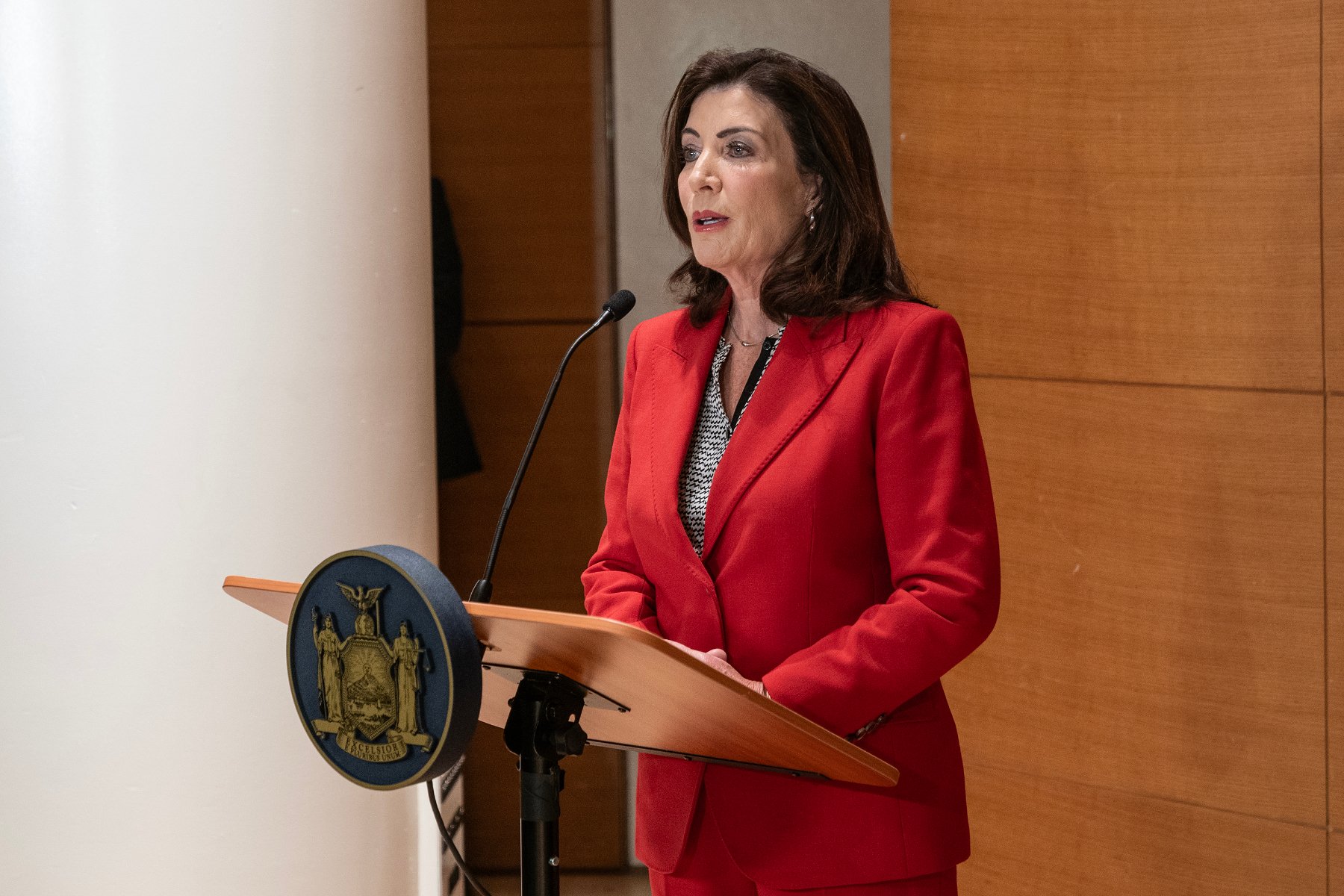At The 19th, we’re committed to publishing journalism that you can trust throughout the critical moments that shape our democracy and our lives. Show your support during our Fall Member Drive, and your donation will be matched. Double your gift today.
When New York’s Adult Survivors Act took effect in November 2022, it offered a rare opportunity for survivors of sexual assault. For one year, the state removed its time restrictions on civil lawsuits and allowed adult survivors to sue their abusers and the institutions that protected them no matter when the attacks occurred.
In the months following the law, only a few dozen civil cases were filed. As the November 24 deadline neared, however, hundreds of suits poured in — nearly 3,000 in total — with allegations against powerful figures in entertainment, politics, law enforcement and beyond.
With the law now expired, lawyers and experts spoke with The 19th about what’s next for current cases. They also said the Adult Survivors Act may create a pathway for similar policies that seek to recognize the needs of survivors and provide new opportunities to obtain justice.
What is New York’s Adult Survivors Act?
The Adult Survivors Act, signed by Gov. Kathy Hochul in 2022, lifted the state’s statute of limitations for one year to allow adults to file civil lawsuits for sexual misconduct no matter when it occurred.
Statutes of limitations vary by crime and seek to ensure a fair process for those accused of offenses as evidence erodes over time.
Before 2019, an accuser in New York had to file a civil suit within three years of sexual misconduct. That year, the state expanded its statute of limitation for some sex crimes to 20 years, but it did not allow for legal action in cases where the statute of limitations had already expired.
The Adult Survivors Act offered a remedy. It was modeled after the 2019 Child Victims Act, which similarly provided a limited lookback window for survivors of childhood sexual abuse.
Neither policy affects whether criminal action is taken, though the statute of limitation may prevent criminal charges.
Notably, the laws allowed for legal action against individual abusers as well as institutions that protected them. Lisa Banks, a partner with the Washington, D.C.-based law firm Katz Banks Kumin, which litigates sexual harassment and gender discrimination cases said that the #MeToo movement highlighted how industries and corporations enable abusers like former film producer Harvey Weinstein. This led to repeat offenses without consequence.
“I think the idea and the hope was that the law would serve as a wake up call to companies, universities, all sorts of institutions, that for decades have been working hard to shield themselves from liability or to hide these kinds of abuses,” Banks said.
Who has filed suit under the New York Adult Survivors Act, and what are their claims?
Headlines about celebrities dominated much of the coverage of lawsuits under the Adult Survivors Act. In May, a jury found that Donald Trump sexually abused and defamed writer E. Jean Carroll. The Adult Survivors Act opened the opportunity for Carroll’s lawsuit, which was tied to a decades-old rape allegation against the former president. Ultimately she was awarded $5 million in damages.
More recently, claims against other powerful men came to light. This included Weinstein, actor Bill Cosby, actor Cuba Gooding Jr., New York City Mayor Eric Adams and music mogul Sean “Diddy” Combs.
Coverage of cases involving celebrities probably raised public awareness about the law and helped other survivors feel more comfortable with suing, Banks said.
“Many people may be learning about the Adult Survivors Act for the first time, so I do think the publicity leads to transparency and education for others,” Banks said. She also noted that many cases are settled out of court and would not be counted in the total number of cases filed under the law.
Beyond entertainment and politics, allegations against members of law enforcement and corrections were another sizable segment of the civil suits filed. Anna Kull is a partner at the firm Levy Konigsberg in New York who has largely focused on representing survivors of child sex abuse and challenging institutional complicity in such abuse.
When the Adult Survivor Act went into effect, a woman told Kulls that she had been assaulted by a correctional officer while she was incarcerated. Researching further, Kull said she found a “staggering” number of similar allegations of sexual abuse by prison staff. Of the roughly 630 cases Kull filed that were affiliated with the Adult Survivors Act, about 600 of them were on behalf of women who were sexually abused by correctional officers while they were incarcerated.
These cases, similarly to the cases of child sexual abuse she has handled, bring attention to pervasive institutional failures, Kull told The 19th. “There’s a clear power imbalance between an inmate and a correctional officer,” she added, citing the limited options available to these women for legal action or protection from future abuse or retaliation.
Another substantial number of plaintiffs in Adult Survivors Act-related suits are former patients of doctors who sexually abused patients. The two main defendants in this category are Dr. Robert Hadden, a OB/GYN formerly affiliated with Columbia University, who has been accused by numerous women of sexually assaulting them while they were undergoing routine medical care, and Dr. Darius Paduch, a urologist formerly affiliated with New York Weill-Cornell Medical Center.
Kull hopes the attention on the Adult Survivors Act will underscore the need for larger systemic changes to the systems that repeatedly enable abuses.

What are the potential implications of these lawsuits, and what recourse do civil suits offer survivors?
“The most important element of the New York Adult Survivors Act is that it creates institutional liability,” said Jacob Eidinger, director of marketing and communications at Crumiller P.C., one of the firms representing the majority of survivors who have filed suit under the law. “Suddenly, survivors are not only able to sue their individual abuser, but any individual or institution that may have played a role in covering up or otherwise enabling the abuse.”
Eidinger emphasized that the majority of lawsuits filed involve institutional defendants, a very large number of whom involved formerly incarcerated individuals who were sexually abused while in custody of the state.
Heather Cucolo, a distinguished adjunct professor at New York Law School and an expert in sexual violent predator law, stressed that these are civil suits, so no criminal sanctions will occur as a result. That means there is no potential for any kind of prison or jail time for alleged offenders.
Civil suits focus on the idea of damages as evaluated through a monetary lens, asking survivors to identify a dollar amount that encapsulates the pain, suffering, loss of wages and mental health toll from their assault. Because of this, Cucolo said, civil suits also often offer the potential for some kind of “reckoning or shame attached to the institutions” that enabled sexual violence to occur, whether by “blatantly ignoring or covering up” these acts.
While many people view criminal cases as the ultimate source of accountability for offenders, civil cases give survivors more agency and voice in the court proceedings, Banks said. While criminal cases are pursued by prosecutors who are ultimately acting on behalf of the local, state or federal government, civil cases directly serve the interests of a client.
There are many times when survivors are disappointed with how a prosecutor pursues or doesn’t pursue a case, Banks said.
“While a survivor could file criminal charges, assuming they’re within the appropriate statute of limitations, they really lose all control of it after that point,” she said. “In the civil context, it’s completely up to the survivor about how they want to proceed.”
Cucolo said it is a huge step forward to have opened up the potential for recourse for survivors whose cases would have otherwise been barred by the statute of limitations — but these cases will still likely face an uphill legal battle. One main reason is the that the passage of time makes cases related to sexual violence harder and harder to prove.
The evidentiary standard for civil cases, however, is a preponderance of evidence — different from the “beyond a reasonable doubt” standard for criminal cases, which should make it easier for prosecutors to prove that there has been some type of pattern of abuse by given individuals or systemic failure by institutions to protect against this form of violence.
What is the timeline for settlements and trials?
Eidinger explained that because all suits are still in the earliest stages, it will likely be two to five years before any of these cases go to trial. Long before a trial can happen, defendants are given the chance to respond to filed litigation. Discovery and document exchanges occur, motions to file for dismissal by defendants may occur, depositions may be taken, and any number of other motions might be filed.
Eidinger also noted that many of the suits recently filed will either be dismissed or settled out of court without going to trial.
Cucolo said that often in sexual violence suits involving high-profile defendants, the defense wants to resolve the case quickly, to get their client’s name out of the spotlight “and make it go away so it doesn’t damage their reputation.” But she doesn’t think that will be the case with the high-profile suits that have emerged from the New York Adult Survivors Act.
“It’s all already out there,” she said. “I don’t know if we’re going to see what we’ve seen in the past, with just trying to sweep it under the rug. I think that’s a benefit when you look at the big picture of the movement. I think this look-back window has had an impact on making this more visible and not allowing perpetrators to hide as easily.”
What future opportunities might exist for survivors to file suits if they did not do so before the expiration of the New York Adult Survivors Act?
In the days following the Adult Survivors Act deadline, attorneys noted the shortcomings of a one-year window of opportunity for retroactive justice.
“A year is not a lot of time to make a decision to file a lawsuit, especially when the allegations involve horrific sexual violence,” Eidinger said.
Because of how difficult — and potentially re-traumatizing — the process of pursuing legal recourse can be for survivors of sexual violence, survivors “need ample time to decide whether this is the right decision for them before they go ahead and file a lawsuit,” he said. “One year is not a lot of time to make this decision generally, and then this is compounded by the fact that many of these survivors are only finding out about the law now, or within the past few weeks or months.”
Eidinger said the Crumiller firm feels “very strongly” that an extension on the New York Adult Survivors Act is needed — and soon. The firm has already begun conversations with the original sponsors of the act about new legislation to again extend the window.
Eidinger added that he anticipated there will be a very specific time limitation built in to any possible extension. (The Child Victims Act created a two-year window; 11,000 suits were filed. Roughly 3,000 cases were filed during the one-year window created by the Adult Survivors Act.)
“We know there are plenty of survivors out there who want a shot at justice,” Eidinger said. He adds that Crumiller has received “dozens and dozens” of calls since the law’s expiration last week from potential clients who are just learning about the New York Adult Survivors Act now and weren’t able to hire a lawyer and file suit before the deadline. “We know there is a huge demand for reopening the window. We think that there will be vast bipartisan support for an extension and we are going to be aggressively advocating for this extension once the legislative session opens up in January.”







